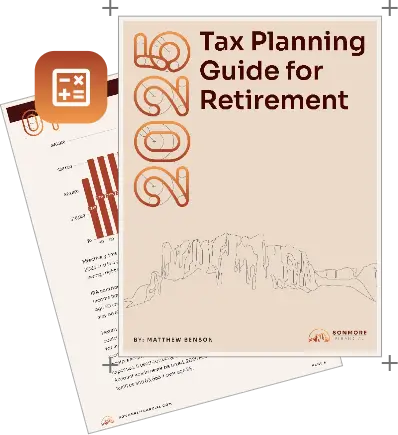Table of contents
When planning for retirement, taxes may be overlooked and can impact your income and financial stability. One of the most misunderstood aspects is the Required Minimum Distribution (RMD), which can unexpectedly push retirees into higher tax brackets, impacting federal taxes and Medicare costs. In this blog, we’ll break down the essentials of RMDs, including how they are calculated, when they begin, and how they may affect tax brackets and Medicare premiums. Additionally, we’ll explore tax-efficient strategies like Roth conversions and Qualified Charitable Distributions (QCDs) to help offset RMD distributions.
What Is an RMD and How Is It Calculated?
RMDs are minimum amounts that retirees must withdraw annually from their tax-deferred retirement accounts, such as 401(k)s, 403(b)s, and traditional IRAs, beginning at age 73 (if born between 1951 and 1959) or 75 (if born in 1960 or later). The IRS sets these mandatory withdrawals, ensuring that funds in tax-advantaged accounts are eventually taxed.
Calculation of RMDs
RMDs are calculated based on your account balance as of December 31 of the previous year and your life expectancy factor, which is determined by IRS tables. The formula to calculate your RMD is:
RMD = Account Balance/Life Expectancy
The life expectancy factor decreases yearly, increasing the RMD amount proportionally as you age. Failing to withdraw the required amount by the end of the year (or by April 1st of the following year for the first RMD) can result in a significant penalty—currently set at 25% of the RMD amount, which can be reduced to 10% if corrected on time.
How RMDs Can Impact Your Tax Bracket and Medicare Costs
When you begin taking RMDs, the withdrawals are taxed as ordinary income. For retirees who have managed to stay within lower tax brackets, these withdrawals can create a “tax balloon,” causing an increase in taxable income that may push them into a higher tax bracket. Additionally, these withdrawals may trigger increases in Medicare premiums through the Income-Related Monthly Adjustment Amount (IRMAA).
Example of RMD Tax Implications
Suppose you have $500,000 in an IRA at age 73, and your life expectancy factor is 26.5. According to IRS tables, your RMD calculation for that year would be approximately:
$500,000/26.5 = $18,868
This RMD amount would be added to your taxable income. If it then pushes your total income over the Medicare IRMAA threshold (for example, $97,000 for individuals and $194,000 for married couples in 2024), you may see a rise in Medicare Part B and Part D premiums.
Strategies to Mitigate RMD and Tax Implications in Retirement
1. Roth Conversions
One strategy to reduce the taxable impact of RMDs is to convert some or all of a traditional IRA to a Roth IRA before RMDs begin. Roth IRAs are not subject to RMDs, and qualified distributions from a Roth account are tax-free, which can be advantageous during retirement.
When to Consider Roth Conversions
Converting to a Roth IRA makes sense if you anticipate your current tax rate being lower than your future tax rate or if you have other assets to cover the tax due on conversion. For instance, if you are in a lower tax bracket before age 73, you can gradually convert portions of your traditional IRA into a Roth IRA each year, effectively spreading the taxes out over time and potentially minimizing its impact on your overall tax rate.
Example
Suppose you have $200,000 in a traditional IRA and choose to convert $40,000 a year for five years. You’ll pay taxes on the $40,000 at your current rate, but future growth on these funds will be tax-free. Additionally, since Roth IRAs do not require distributions, you can allow these funds to grow without being subject to future RMDs.
2. Qualified Charitable Distributions (QCDs)
Another strategy to help offset the impact of RMDs on taxable income is through Qualified Charitable Distributions (QCDs). If you’re charitably inclined, QCDs allow you to donate directly from your IRA to a qualified charity without including the distribution in your taxable income. These can be particularly advantageous because for many retirees their charitable gifts may not be high enough to itemize and receive a tax benefit if given from cash. Additionally, QCDs count as an “above the line” deduction, which reduces your Adjusted Gross Income (AGI) and helps to benefit things like IRMAA, where a traditional charitable gift would not provide this benefit.
How QCDs Work
QCDs can be made starting at age 70½, allowing retirees to donate up to $100,000 per year directly to charity. The QCD amount is excluded from your taxable income and counts toward satisfying your RMD. This can be an appropriate option if you’re concerned about the tax implications of a RMD pushing you into a higher bracket.
Example
If you must take a $20,000 RMD but donate $10,000 to a qualified charity via a QCD, only the remaining $10,000 will count toward your taxable income. This strategy can help reduce your tax burden while supporting causes you care about.
Additional Tips for Managing RMDs and Taxes in Retirement
Consider Optimizing Withdrawal Order
Consider taking funds from taxable accounts first, which could reduce your taxable income if the funds have already been taxed. This approach can help preserve your tax-deferred accounts longer, allowing them to grow while minimizing immediate tax impact. This may also present an opportunity to do Roth conversions while your income may be lower.
Consider Delaying Social Security Benefits
Delaying Social Security benefits until age 70 can provide a higher monthly benefit and may reduce the need to withdraw from tax-deferred accounts early. This strategy can help reduce your taxable income from Social Security benefits, particularly during the years before RMDs begin.
Consider Utilizing Tax-Efficient Investments in Taxable Accounts
Investing in tax-efficient assets—like municipal bonds and ETFs—in your taxable accounts may minimize your taxable interest income. This strategy can be particularly beneficial if you’re working to avoid IRMAA and stay within a lower tax bracket.
Work with a Financial Advisor or Tax Professional
It can be complex to navigate RMDs and the various strategies available to minimize their impact on your taxes. A financial advisor or tax professional can help tailor these strategies to your unique situation, guiding you through Roth conversions, QCDs, and other ways to optimize your tax situation in retirement.
Conclusion
Required Minimum Distributions are essential to retirement planning, but they can have tax implications if not managed effectively. Understanding how RMDs are calculated and exploring options like Roth conversions and Qualified Charitable Distributions can make a difference in controlling your taxable income, staying within desired tax brackets, and managing Medicare premiums. We believe reviewing your income sources, exploring tax-saving strategies, and working with professionals to help ensure your retirement funds last may be wise retirement approaches.
Planning and staying informed about these strategies will help empower you to maximize your hard-earned savings and enjoy the retirement you’ve imagined.
References
Retirement topics – required minimum distributions (rmds). Internal Revenue Service. (n.d.). https://www.irs.gov/retirement-plans/plan-participant-employee/retirement-topics-required-minimum-distributions-rmds
Social Security in retirement. Social Security. (n.d.). https://www.ssa.gov/retirement
Warren, K. (n.d.). Qualified charitable distribution (QCD): What it is and how it lowers your taxes. Investopedia. https://www.investopedia.com/qualified-charitable-distribution-qcd-5409491
What is IRMAA, and what are the 2024 IRMAA brackets? NerdWallet. (n.d.). https://www.nerdwallet.com/article/insurance/medicare/what-is-the-medicare-irmaa
What to know about saving for retirement and Roth Ira Conversions | Morningstar. (n.d.). https://www.morningstar.com/personal-finance/what-know-about-saving-retirement-roth-ira-conversions



